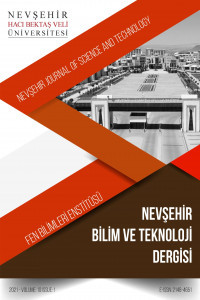Polietilen ve Kereste Tozlarının Ko-pirolizi: Piroliz Ürün Değeri Üzerinde Polietilenin Etkisi
Alternatif Enerji, Element Analizi, Piroliz, Atık Azaltma
Co-pyrolysis of Polyethylene and Sawmills Powder: Influence of Polyethylene on Pyrolysis Product Value
Alternative Energy, Elemental Analysis, Pyrolysis, Waste Reduction,
___
- Orhan Y., Hrenovic J., Büyükgüngör H., “Biodegradation of Plastic Compost Bags Under Controlled Soil Conditions”, Acta Chimica Slovenica, 51, 579-588, 2003.
- Khan, M.S., Kaneesamkandi Z., Biodegradable waste to biogas: renewable energy option for the Kingdom of Saudi Arabia. Int., J. Innovation Applied Study, 4 (1), 101–113, 2013.
- Siddiqui, M.N., Redhwi, H.H., Pyrolysis of mixed plastics for the recovery of useful products. Fuel Process Technology, 90, 545-552, 2009.
- Miandad, R., Barakat, M.A., Aburiazaiza, A.S., Rehan, M., Nizami, A.S., Catalytic pyrolysis of plastic waste: A review, Process. Saf. Environ. Prot. 102, 822-838, 2016a.
- Achilias D.S., Roupakias C., Megalokonomos P., Lappas A.A., Antonakou Ε.V., Chemical recycling of plastic wastes made from polyethylene (LDPE and HDPE) and polypropylene (PP), Journal of Hazardous Materials, Volume 149, Issue 3, Pages 536–542 Edited By E. Gidarakos and N.P. Nikolaidis, 2007.
- Lopez, A., Marco, I.D., Caballero, B.M., Laresgoiti, M.F., Adrados, A., Aranzabal, A., Catalytic pyrolysis of plastic wastes with two different types of catalytic: ZSM-5 zeolite and Red Mud. Applied Catal. B: Environment, 104, 211–219c, 2011a.
- Lopez, A., De Marco, I., Caballero, B.M., Laresgoiti, M.F., Adrados, A., Influence of time and temperature on pyrolysis of plastic wastes in a semi-batch reactor. Chem. Eng. J., 173, 62-71, 2011.
- Lopez, A., Marco, I.D., Caballero, B.M., Laresgoiti, M.F., Adrados, A., Catalytic stepwise pyrolysis of packaging plastic waste, J. Anal. Applied Pyrolysis, 96, 54–62, 2012.
- Chen, D., Yin, L., Wang, H., He, P., Pyrolysis technologies for municipal solid waste: a review. Waste Management, 34, 2466-2486, 2014.
- Buah W.K., Cunliffe A.M., Williams P.T., Characterization of Products from the Pyrolysis of Municipal Solid Waste, Process Safety and Environmental Protection, Volume 85, Issue 5, 450–457, 2007.
- Velghe, I., et al., Study of pyrolysis of municipal solid waste for the production of valuable products, Journal of Analytical and Applied Pyrolysis, 92 (2) 366-375, 2011.
- Zeaiter, J., A process study on the pyrolysis of waste polyethylene, Fuel, 133, 276-282, 2014.
- Syamsiro, M., Shuo Cheng, Wu Hu, Harwin Saptoadi, Nosal Nugroho Pratama, Wega Trisunaryanti, Kunio Yoshikawa, Liquid and Gaseous Fuels from Waste Plastics by Sequential Pyrolysis and Catalytic Reforming Processes over Indonesian Natural Zeolite Catalysts, Waste Technology, Vol. 2(2), 44-51, 2014.
- Lee, K.H., Shin, D.H., Characteristics of liquid product from the pyrolysis of waste plastic mixture at low and high temperatures: influence of lapse time of reaction. Waste Management, 27, 168–176, 2007.
- Siddiqui, M.N., Redhwi, H.H., Pyrolysis of mixed plastics for the recovery of useful products. Fuel Process Technology, 90, 545–552, 2009.
- Miskolczi, N., Angyal, A., Bartha, L., Valkai, I., Fuel by pyrolysis of waste plastics from agricultural and packaging sectors in a pilot scale reactor. Fuel Process Technology, 90, 1032–1040, 2009.
- Lee, K.H., Effects of the types of zeolite on catalytic upgrading of pyrolysis wax oil., J. Anal. Applied Pyrolysis, 94, 209–214, 2012.
- Panda A.K., Singh R.K., Mishra D.K., Thermolysis of waste plastics to liquid fuel A suitable method for plastic waste management and manufacture of value added products—a world prospective. Renew Sustainable Energy Rev, 14: 233–48, 2010.
- Hugo T.J., Pyrolysis of Sugarcane. Department of Process Engineering University of Stellenbosch, 2010.
- Montoya J.I., Valdés C., Chejne F., Gómez C.A., Blanco A., Marrugo G., et al., Bio-oil production from Colombian bagasse by fast pyrolysis in a fluidized bed: an experimental study, J Anal Applied Pyrolsis, 112: 379–87, 2015.
- Abnisa F., Wan Daud W.M.A., Ramalingam S., Azemi MNBM, Sahu J.N., Co- pyrolysis of palm shell and polystyrene waste mixtures to synthesis liquid fuel. Fuel, 108: 311–318, 2013.
- Brebu M., Ucar S., Vasile C., Yanik J., Co-pyrolysis of pine cone with synthetic polymers., Fuel
- Cornelissen T., Yperman J., Reggers G., Schreurs S., Carleer R., Flash co-pyrolysis of biomass with polylactic acid. Part 1: influence on bio-oil yield and heating value.
- Anuar Sharuddin S.D., Abnisa F, Wan Daud W.M.A., Aroua M.K., A review on pyrolysis of plastic wastes. Energy Convers Management, 115:308–26, 2016.
- ISSN: 2148-466X
- Yayın Aralığı: Yılda 2 Sayı
- Başlangıç: 2012
- Yayıncı: Nevşehir Hacı Bektaş Veli Üniversitesi
Hasan Hüseyin DERTLİ, Fezayil SUNCA, Mehmet AKKÖSE
Çevresel Su Örneklerinde GC/MSD ile Pestisit Analizi ve Metot Validasyonu
Kızılırmak Havzasının Hidrometeorolojik Verilerinin Trend Analizi
Burcu ERCAN, Mehmet İshak YÜCE
Eskişehir’de Yer Alan Bazı Sulama Göletlerinin Su Kalitesinin Değerlendirilmesi
Arzu ÇİÇEK, Erhan UYSAL, Esengül KÖSE, Cem TOKATLI
Fenton ve Fotofenton Prosesleri ile Atıksudaki Aspirinin Giderim Verimliliğinin Karşılaştırılması
Sevde ÜSTÜN ODABAŞI, Bareera MARYAM, Hanife BÜYÜKGÜNGÖR
MOF-5 Bağlı Karışık Matriksli Membranların Sentezi, Karakterizasyonu ve Gaz Ayırma Özellikleri
Hülya AYKAÇ ÖZEN, Bahtiyar ÖZTÜRK, Hamdi ÖBEKCAN
Muhammed Azim EIRGASH, Vedat TOĞAN, Aynur KAZAZ
Bazı İlaç Kalıntılarının US ve US/H2O2 Prosesleri ile Giderimi
Polietilen ve Kereste Tozlarının Ko-pirolizi: Piroliz Ürün Değeri Üzerinde Polietilenin Etkisi
Sinem UĞUZ, Tolga AYERİ, Yüksel ARDALI
Sulardan Humik Asit Gideriminde Demir Kaplı Zeolitle (DKZ) Katalitik Ozonlama
